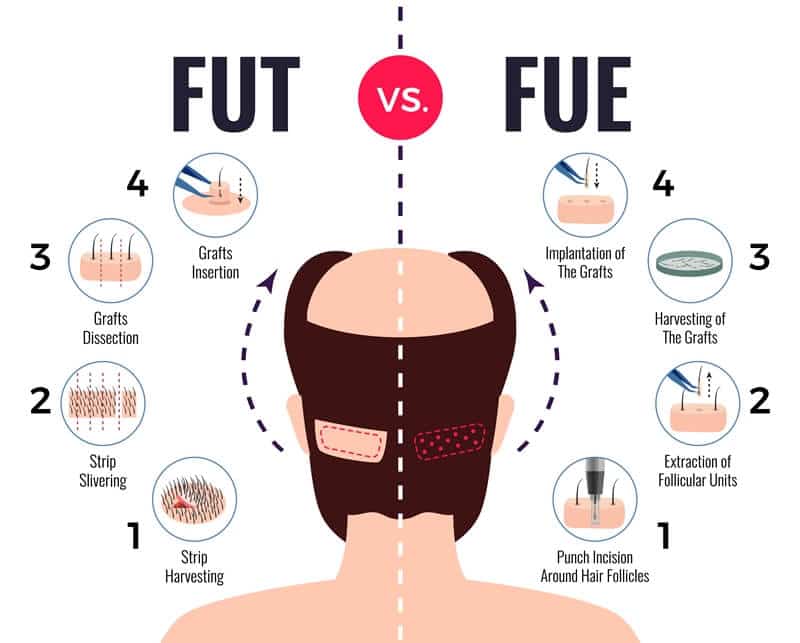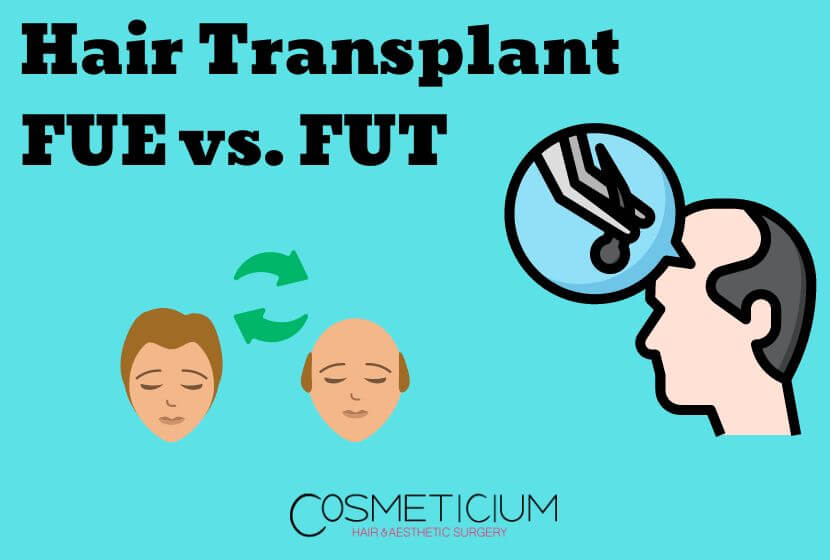Hair transplantation is a very important treatment option for those who have lost their hair permanently. The FUT and FUE techniques used in this treatment have proven success in general. When we look at the methods, it can be seen that the most important difference is the collection of grafts from the donor area. The cultivation of grafts is generally the same.
Hair transplantation is more effective and successful than other non-surgical methods applied against hair loss. 80% or even more of the hair transplanted with a successful operation can come out in the first 4 months after the operation. However, it should be kept in mind that this whole process requires professionalism and the relevant treatment may not be suitable for everyone.
We have made a comparison of FUE and FUT techniques in hair transplantation for you. All comparisons such as success rates, pros and cons are in our article.
Table of Contents
Hair Transplant FUE vs. FUT
Hair transplantation for sparse or bald areas on the scalp is a procedure in which the grafts taken from the donor area are transferred to these areas. In these procedures, the nape or other parts of the body are preferred as the donor site. The procedure both improves the overall appearance and increases self-confidence.
Two of the methods used in hair transplantation are FUT and FUE techniques. FUE; is follicular unit extraction, while FUT is dolicular unit transplantation.
In the FUE technique, the grafts are collected one by one, while in the FUT technique, they are removed as a long strip. The follicles extracted as strips are then separated and transplanted one by one.

FUT can give effective results in terms of high quality grafts. Grafts are taken in strip form, then follicular units are separated into dissection stereo microscopes. Although it is a method frequently used in the 2000s, it is no longer preferred as before after the FUE method.
High-quality grafts are used in the FUE technique and the success rate is higher. Since the grafts are collected one by one, there is no obvious scar as in the FUT method. In the rest of our article, we will talk about FUE and FUT techniques in more detail.
Follicular Unit Transplantation (FUT) Hair Transplantation Procedure
In the FUT technique, the grafts are removed from the donor area in the form of strips and the opening is closed by suturing the relevant area. Afterwards, the strip removed by the surgeon performing the procedure is divided into small pieces. These parts, called grafts, contain three or four hair follicles.
After this stage, very small incisions are made in the area where the grafts will be transplanted, using a microscope, needle and a special knife. Finally, the grafts are carefully placed in these incisions, and then the relevant area is covered with gauze and bandage. All these procedures are performed under local anesthesia.
Advantages |
Disadvantages |
| Lower costs | Needs stiches |
| Shorter operation time | Depending on the stiches, scars may remain. |
| Large sessions are easier | Recovery time is longer |
| In the future, it can be processed again with the FUE or FUT technique | Causes more discomfort |
| It is an older technique than the FUE technique. |
Follicular Unit Extraction (FUE) Hair Transplantation Procedure
In FUE or in other words follicular unit extraction technique, grafts are collected one by one from the donor area. Shaving the relevant area before this process makes the process easier. Small incisions are made in the bald area for the collected grafts and the hair follicles are placed there and the process is completed.
Advantages |
Disadvantages |
| Recovery time is only a few days. | The cost is slightly higher. |
| Short hair style can be done | The procedure time is longer, which can be a more tiring process for patients. |
| Only small dot-shaped scars are formed in the donor areas and these can disappear after a while. | The number of grafts that can be transplanted in a single session is limited. Therefore, an additional session may be needed in excessive baldness. |
| No stiches needed. | The donor area needs to be shaved. |
| There is no need to come back for stitches to be removed. | |
| It is a much newer technique with a high success rate. |
While the FUE technique can be applied to most people, it may not be a suitable method for everyone. In particular, patients with ongoing hair loss should be evaluated in detail during the consultation process.
The procedure is performed under local anesthesia. This minimizes the risk of complications in the procedure. It also contributes to making the healing process more comfortable and shorter. There are no problems such as scarring after the procedure.
What are the Factors Affecting the Choice?
Both methods generally give effective results. The main reason why the results are similar is the same method used for transplanting the grafts taken from the donor area to the balding area. However, it should be noted that the FUE technique is a newer and more modern technique and does not cause any scars after the procedure.
While choosing between these two methods, it is necessary to consider other factors besides the features of the techniques. These elements are as follows:
- Age
- Condition of the donor area
- The amount of hair loss
- General attitude of the patient
The most ideal technique for the patient is selected by the surgeon, taking into account all of these issues and the features of the techniques.
Things to Be Considered
There are important details about techniques to consider when choosing. These can be listed as follows:
- In some rare cases where the hair is brittle or the scalp is very thick, FUE may not be possible. FUT can be inevitable.
- FUT is an easily reproducible technique. Therefore, those who have had hair transplantation with the FUT technique before can have the procedure repeated with FUT or FUE in the later periods. 3000 grafts can be transplanted in a single session with FUE. If necessary, a second session can be applied in the FUE technique.
- A combination of both techniques may be required in larger cases.
What Exactly Is The Difference Between FUE and FUT?
Although the FUT and FUE techniques used in hair transplantation are similar in terms of results, there are significant differences between them. FUE is a less invasive procedure, while FUT is more invasive. However, the main difference between them is the way grafts are taken from the donor area.
- When removing hair in the FUT technique, a hair strip is removed from the relevant area and a scar is formed accordingly.
- In the FUE technique, the grafts are taken one by one, so only spot-sized scars may remain. These are also unnoticeable when you look from the outside.
Patients who prefer the FUT technique have to lengthen their hair or use similar methods to cover this scar that occurs in the later period.
Since FUE is less invasive, the recovery time is short and the risk of complications is low.
Read Also: Can A Dermatologist Help With Hair Loss? What to Expect?
Which Method Is More Suitable For Whom?
Which method will be preferred will be decided in consultation with your doctor. A decision is made at this point, taking into account the features of the techniques and the general condition of the patients.
FUE is one of the most modern techniques in this field and is suitable for almost any candidate. This situation causes it to be preferred more and more today.
Hair Loss FAQs
Frequently asked questions about hair transplantation and their answers are as follows.
- Can both FUT and FUE be done?
Yes, both techniques can be applied to the same person. Sometimes FUT is applied first so that the scalp can become tighter. If such a situation occurs, the transition to the FUE technique can be possible.
- How Long Does Hair Transplantation Take?
While the FUT technique takes between 4 – 12 hours depending on the number of follicles to be transplanted, FUE can take up to 6 – 10 hours. Depending on the size of the operation, an additional session may be required.
- Will There Be Any Traces After Hair Transplantation?
In the FUT technique, scars remain in the donor area. This scar is usually thin and long. It is obvious when viewed from the outside, it can only be hidden by lengthening the hair. In the FUE technique, spot-sized scars may occur. These are not noticeable from the outside.
- Is pain felt during and after the procedure?
The procedures are performed with local anesthesia. Therefore, pain is not felt during the procedure. After the procedure, if needed (which is not usually needed), painkillers allow this period to be overcomed comfortably.
- What should be considered after the procedure?
The procedure does not affect social life in general. It is important not to touch the operated area for the first three days and to protect this area. Your doctor will give you some instructions on what to watch out for. You must comply with these.
- Is FUE Hair Transplant the Final Solution?
The success rate of the FUE technique is generally higher than 95%. After the procedure performed by a specialist surgeon, you can have permanent hair by paying attention to the points to be considered.
Read Also: Difference Between DHI and FUE
Plan A Consultation at COSMETICIUM
General details about hair transplant FUE vs FUT is as described in the article. The fact that the FUE technique is more modern, leaves no traces, and has a high success rate makes it one step ahead.

In order to obtain the desired result from these techniques, the procedure should be performed by experienced and expert surgeons. In addition, a clinic with medical competence should be preferred. As COSMETICIUM, we meet your expectations about this and offer you high quality hair transplant service. For more detailed information, you can contact us now.
Fill In The Form Below To Get Answers To All Your Questions About Hair Transplant From Our Doctors Within Hours. (FREE)

